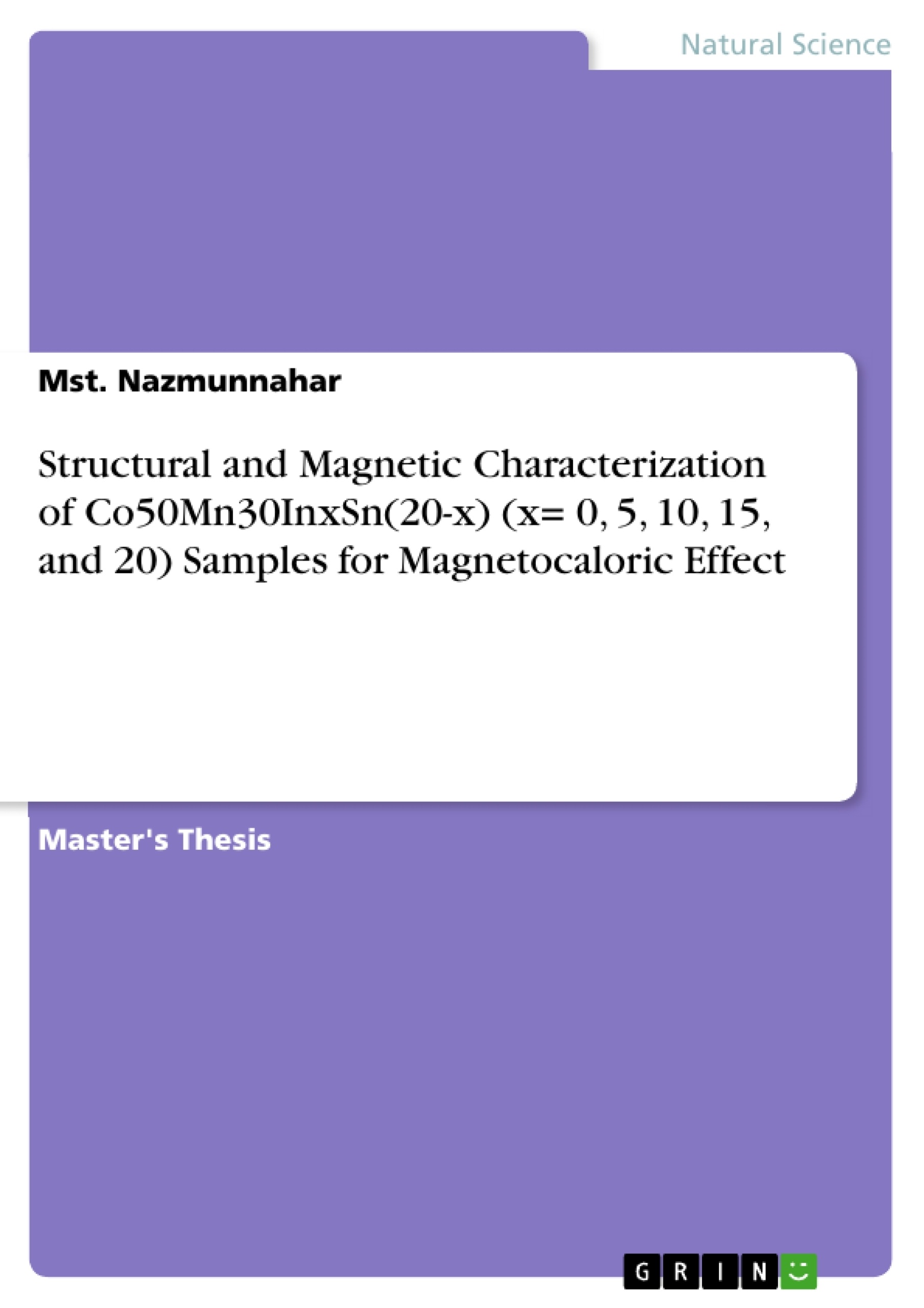Nowadays magnetic refrigeration which is based on the Magnetocaloric Effect (MCE) is one of the more relevant topics in the scientific research owing to its very important technological applications, which derive from the attempts made to replace the gas refrigerating technology involving, among other transcendental aspects, a low impact in the environment and an expected higher energetic efficiency. Furthermore, new and improved magnetocaloric materials are one of the cornerstones in the development of room temperature magnetic refrigeration. This master’s work has mainly been concerned in a development of a deep and systematic study of magnetic and magnetocaloric properties of ribbon samples of Heusler alloy family of materials with compositions susceptible of exhibiting MCE, For this purpose, we have focused on ribbons of chemical composition Co50Mn30InxSn (20-x) (x= 0, 5, 10, 15, and 20).
Co50Mn30InxSn (20-x) Heusler alloys were prepared by arc melting admixtures of the pure elements in the desired quantities under argon atmosphere. The ribbons have been prepared by melt spinning technique. X-ray characterization proved the face centered cubic austenite Heusler alloy phase (211) crystal structural with lattice constant a = 0.5947 nm of as cast and annealed ribbons. Differential Scanning Calorimetry was used to find the temperatures of the recrystallization phase transitions. Magnetization was measured for as-cast and annealed samples. Both Curie temperatures and coercivity were found to be lower in the as-cast samples than in the glass tube annealed ones. Monotonic decreasing of the Curie temperature was observed in the series with the growth of the content.
MCE has been evaluated for one of the samples (x = 15) and a maximum value of entropy change is 2.37 JKg-1K-1 have been found, which is the same order of magnitude that reported of Gd alloys.
Inhaltsverzeichnis (Table of Contents)
- Chapter One: Magnetocaloric effect and Heusler alloy
- 1.1 Introduction
- 1.2 Thermodynamics of magnetocaloric effect
- 1.3 Measurements of MCE
- 1.4 Magnetic Refrigeration and Materilas
- 1.5 Magnetocaloric materials
- 1.6 Heusler alloy
- 1.7 Aim of the work
- Chapter Two: Sample Preparation and Experimental Techniques
- 2.1 Preparation of samples
- 2.1.1 Arc melter
- 2.1.2 Melt Spinner
- 2.1.3 Sample Preparation
- i) Master alloy
- ii) Ribbon Preparation
- 2.2 Instrumentations
- 2.2.1 Preparation of system for annealing sample
- 2.2.2 Differential Sanning Calorimetry
- 2.2.3 Powder X-ray diffractometer
- 2.2.4 Physical Property Measurement System(PPMS)
- 2.2.5 Vibrating Sample Magnetometer(VSM)
- Chapter Three: Results and Discussion
- 3.1 DSC Results
- 3.2 XRD Results
Zielsetzung und Themenschwerpunkte (Objectives and Key Themes)
This thesis investigates the structural and magnetic properties of Co50Mn30In20-xSnx (x= 0, 5, 10, 15, and 20) Heusler alloys for their potential application in magnetic refrigeration. The main goal is to understand the influence of Sn substitution on the magnetocaloric effect of these alloys.- The study explores the correlation between structural and magnetic properties of the alloys.
- It examines the impact of Sn substitution on the magnetocaloric effect of Co50Mn30In20-xSnx alloys.
- The research focuses on characterizing the structural and magnetic properties of the samples using various experimental techniques.
- The thesis investigates the potential of these Heusler alloys for use in magnetic refrigeration applications.
Zusammenfassung der Kapitel (Chapter Summaries)
- Chapter One: Magnetocaloric effect and Heusler alloy: This chapter introduces the magnetocaloric effect, a phenomenon where a material's temperature changes upon exposure to a magnetic field. It discusses the thermodynamics of the effect, its measurement techniques, and its applications in magnetic refrigeration. The chapter also introduces Heusler alloys, a class of intermetallic compounds known for their interesting magnetic properties, and explores their potential as magnetocaloric materials.
- Chapter Two: Sample Preparation and Experimental Techniques: This chapter details the sample preparation process, including the use of an arc melter and a melt spinner. It describes the different instrumentation used for characterization, such as Differential Scanning Calorimetry (DSC), Powder X-ray Diffractometer (XRD), Physical Property Measurement System (PPMS), and Vibrating Sample Magnetometer (VSM). This section explains the procedures for annealing the samples and preparing them for analysis.
- Chapter Three: Results and Discussion: This chapter presents the results obtained from the experimental analysis of the Co50Mn30In20-xSnx samples. The chapter discusses the structural and magnetic properties of the alloys, as well as their potential for use in magnetic refrigeration applications. It analyzes the data from DSC and XRD measurements, revealing the impact of Sn substitution on the alloys' properties.
Schlüsselwörter (Keywords)
The primary focus of this work is on the structural and magnetic characterization of Heusler alloys for magnetic refrigeration. Key terms include magnetocaloric effect, Heusler alloys, Co50Mn30In20-xSnx, Sn substitution, magnetic refrigeration, structural characterization, magnetic properties, DSC, XRD, PPMS, and VSM. These terms are essential to understanding the research objectives, the materials investigated, and the experimental techniques employed.- Citation du texte
- Mst. Nazmunnahar (Auteur), 2010, Structural and Magnetic Characterization of Co50Mn30InxSn(20-x) (x= 0, 5, 10, 15, and 20) Samples for Magnetocaloric Effect, Munich, GRIN Verlag, https://www.grin.com/document/181811



